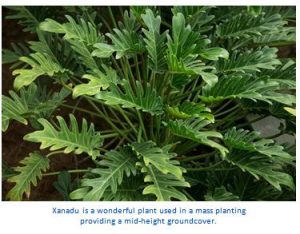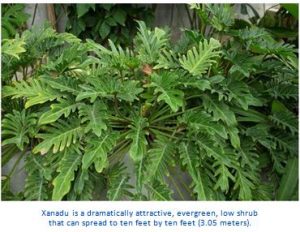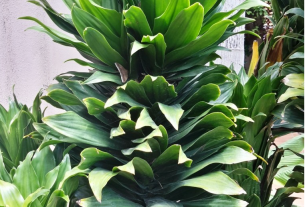By Tommy Clarkson from the September 2017 Edition
Xanadu Xanadu philodendron
Family: Araceae
Also known as: Philodendron Xanadu, Philodendron ‘Winterbourn’, Philodendron ‘Aussie’ or Philodendron Xanadue
But for our immediate, horticultural purposes, Xanadu is a dramatically attractive, evergreen, low shrub that can spread to ten feet by ten feet (3.05 meters) and grow to around two feet, six inches (72.20 cm) high and if the conditions are right, all of the proper stars aligned and correct attention given, even larger in size! China and Hollywood notwithstanding, it is believed to have originated in southeastern Brazil.
It’s trivia time! However, this may require us to turn the clock back a ways! Here goes: Beyond the 2007 musical by that name, where and what was Xanadu?
 Firstly, Xanadu (also known as Shangdu) was the capital of the Chinese Yuan dynasty. Created by Kublai Khan, Genghis Khan’s grandson, it was founded in 1271 and ruled by him until his death in 1294. Secondly, it was also the massive, fictional estate of Charles Foster Kane, the title character of the 1941 film – somewhat controversial at the time classic, Citizen Kane, written, directed and starring Orson Welles. And lastly, it was the subject of a poem by Samuel Taylor Coleridge that starts: “In Xanadu did Kubla Khan, A stately pleasure dome decree: Where Alph, the sacred river, ran Through caverns measureless to man Down to a sunless sea.” (Miss Marcena Pettijohn, my wonderfully professional high school English teacher, would be so proud that I remembered this)
Firstly, Xanadu (also known as Shangdu) was the capital of the Chinese Yuan dynasty. Created by Kublai Khan, Genghis Khan’s grandson, it was founded in 1271 and ruled by him until his death in 1294. Secondly, it was also the massive, fictional estate of Charles Foster Kane, the title character of the 1941 film – somewhat controversial at the time classic, Citizen Kane, written, directed and starring Orson Welles. And lastly, it was the subject of a poem by Samuel Taylor Coleridge that starts: “In Xanadu did Kubla Khan, A stately pleasure dome decree: Where Alph, the sacred river, ran Through caverns measureless to man Down to a sunless sea.” (Miss Marcena Pettijohn, my wonderfully professional high school English teacher, would be so proud that I remembered this)
Who says one can’t attain a bit of couth, class, culture and literary decorum while studying tropical plants?
Xanadu is a wonderful plant used in a mass planting providing a mid height ground cover.
However, that said, Kirsten Albrecht Llamas, in her book Tropical Flowering Plants identified this plant as a “Swiss Cheese Plant (or) Taro Vine Monstera adansonii, in the Monstera genus, and said that it comes from the range between Central America and Brazil! But, further digging unearthed that several botanical authorities are in total disagreement as to whether or not this is a hybrid of the P. selloum, or a separate and individual species all unto itself. I agree with the latter and, accordingly, choose to proceed with such contention! Is it any wonder why I so often babble incoherently to myself?
It is one of around five hundred tropical American herb, shrub and climbing species that as a result of their poisonous sap can be lethal to small children or pets if ingested. Its name, Philodendron, speaks to much of its nature, in that this word stems from the Greek one for “tree loving”.
Unlike many Philodendrons, the Xanadu is an upright plant, not a climber or vine. Like them, however, the individual leaves of the Xanadu philodendron are a delight. These, of this exotic looking plant, can be as large as 16-18 inches (40.64-45.72 cm) long and 7-14 inches (17.78-35.56 cm) wide.
Shy and retiring like me (I heard that snort of derision) seldom seen are its flowers featuring dark red spathes. It also has significantly less aerial roots, like those seen trailing to the ground from its kin, the larger Philodendron bipinnatifidum. The Xanadu Philodendron needs more light than most other philodendrons so that it can properly maintain its compact appearance.
Hence, the challenge is to find just the right amount of partial shade and indirect sunlight. Too much of old Sol’s direct rays will cause the leaves to become pale and bleached in appearance. On the other hand, the plant will spend its time and energy reaching for sunlight if in too shady of environs. Once you’ve found the perfect growing locale, feed your Xanadu monthly to keep it a deep green color.
Apply fertilizer in the spring and fall, every other week during the hottest season and, if you’ve chilliness during the winter, none at all then.
At the basest of levels, as a tropical species, it needs warmth and humidity to survive. It might attract aphids and mealy bugs, but is not known to be invasive. If growing indoors, keep your Xanadu near natural light and take it outside to rinse it off weekly. As it grows, and should you so wish, you may propagate it by plant division.
The individual leaves of the leaves of the Xanadu philodendron are, in themselves, a delight to behold.
Xanadu is wonderful plant used in a mass planting providing a mid-height ground cover. It also makes a super foundation planting, a spreading climber or, as noted previously, growing in a container – inside or out of doors. It’s sure to generate comments and – armed with the trivia, minutia and the facts above – just imagine how you can wow your guests!
Download the full edition or view it online
—
Tommy Clarkson is a bit of a renaissance man. He’s lived and worked in locales as disparate as the 1.2 square mile island of Kwajalein to war-torn Iraq, from aboard he and Patty’s boat berthed out of Sea Bright, NJ to Thailand, Germany, Hawaii and Viet Nam; He’s taught classes and courses on creative writing and mass communications from the elementary grades to graduate level; He’s spoken to a wide array of meetings, conferences and assemblages on topics as varied as Buddhism, strategic marketing and tropical plants; In the latter category he and Patty’s recently book, “The Civilized Jungle” – written for the lay gardener – has been heralded as “the best tropical plant book in the last ten years”; And, according to Trip Advisor, their spectacular tropical creation – Ola Brisa Gardens – is the “Number One Tour destination in Manzanillo”.




